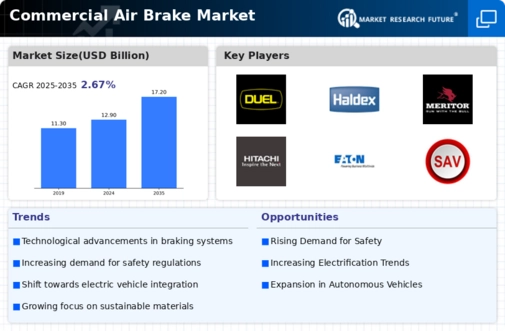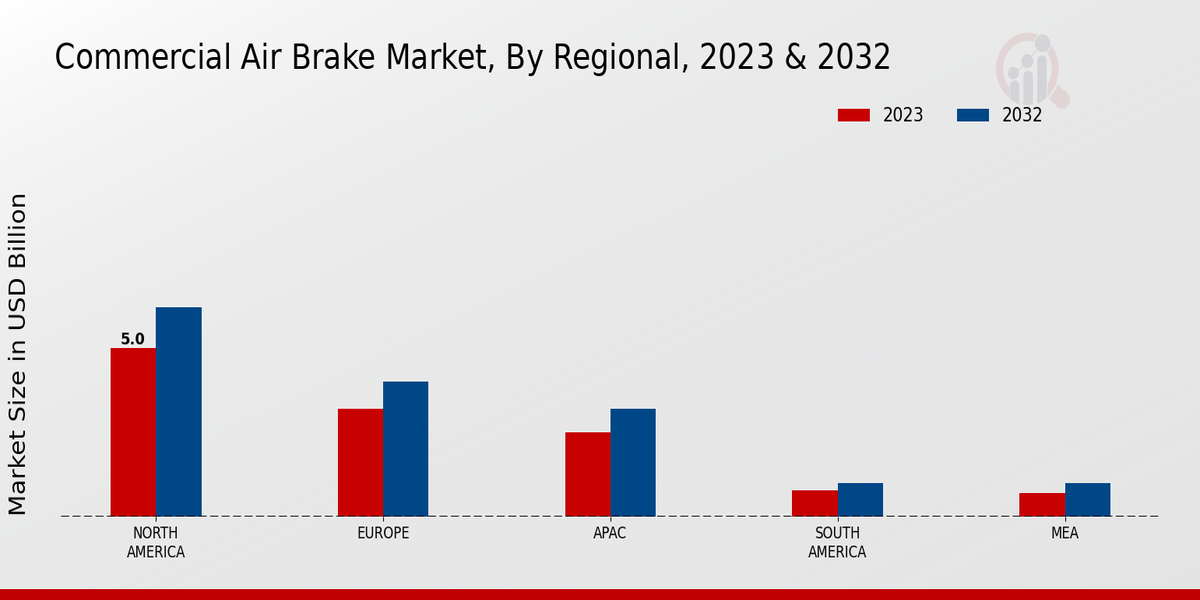Market Growth Projections
The Global Commercial Air Brake Market Industry is poised for growth, with projections indicating a market value of 12.9 USD Billion in 2024, escalating to 17.2 USD Billion by 2035. This growth trajectory suggests a compound annual growth rate (CAGR) of 2.67% from 2025 to 2035. The increasing demand for commercial vehicles, coupled with advancements in braking technologies and regulatory pressures, underpins this positive outlook. As the industry evolves, stakeholders must remain vigilant to emerging trends and innovations that could further influence market dynamics.
Regulatory Standards and Safety Norms
The Global Commercial Air Brake Market Industry is significantly influenced by stringent regulatory standards and safety norms imposed by governments worldwide. These regulations mandate the installation of advanced braking systems in commercial vehicles to enhance safety and reduce accident rates. Compliance with these standards often requires manufacturers to innovate and upgrade their air brake systems, thereby driving market growth. As safety becomes a paramount concern for fleet operators, the demand for reliable air brake systems is likely to increase, contributing to the industry's projected growth to 17.2 USD Billion by 2035.
Growing Demand for Commercial Vehicles
The Global Commercial Air Brake Market Industry is experiencing a surge in demand for commercial vehicles, driven by the expansion of logistics and transportation sectors. As urbanization accelerates globally, the need for efficient freight transport increases, leading to a higher production of commercial vehicles. This trend is projected to contribute to the market's growth, with the industry expected to reach 12.9 USD Billion in 2024. The rising number of delivery services and e-commerce platforms further fuels this demand, necessitating advanced braking systems to ensure safety and reliability in commercial operations.
Market Expansion in Emerging Economies
The Global Commercial Air Brake Market Industry is witnessing significant expansion in emerging economies, where rapid industrialization and urbanization are driving the demand for commercial vehicles. Countries in Asia-Pacific and Latin America are experiencing increased investments in infrastructure, which in turn boosts the need for efficient transportation solutions. This trend is likely to enhance the demand for advanced air brake systems, as manufacturers seek to cater to the growing market. The expansion in these regions is expected to play a pivotal role in the industry's growth, aligning with the projected increase in market value to 17.2 USD Billion by 2035.
Technological Advancements in Braking Systems
Technological advancements play a crucial role in shaping the Global Commercial Air Brake Market Industry. Innovations such as anti-lock braking systems (ABS) and electronic braking systems (EBS) enhance vehicle safety and performance. These technologies not only improve braking efficiency but also reduce wear and tear on brake components, leading to lower maintenance costs for fleet operators. As manufacturers continue to invest in research and development, the adoption of these advanced braking technologies is expected to rise, potentially increasing the market's compound annual growth rate (CAGR) to 2.67% from 2025 to 2035.
Increasing Focus on Environmental Sustainability
The Global Commercial Air Brake Market Industry is also impacted by the growing emphasis on environmental sustainability. As governments and organizations worldwide strive to reduce carbon emissions, there is a push for more eco-friendly commercial vehicles. This shift encourages manufacturers to develop air brake systems that are not only efficient but also environmentally friendly. The integration of lightweight materials and energy-efficient technologies in braking systems aligns with sustainability goals, potentially attracting a broader customer base and contributing to the industry's growth trajectory in the coming years.




















